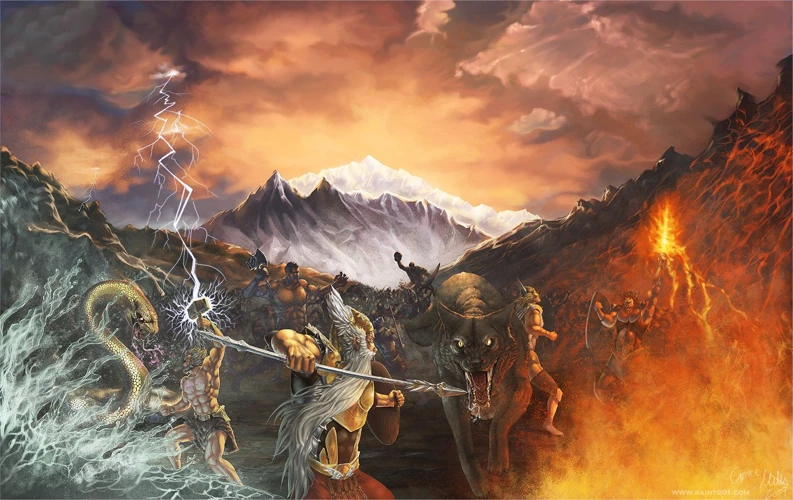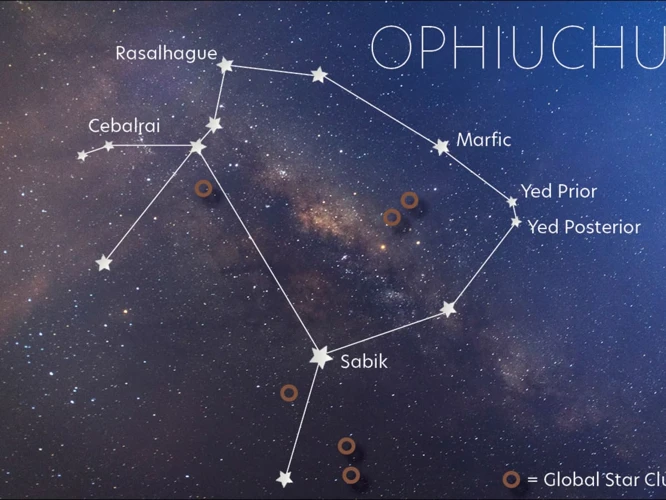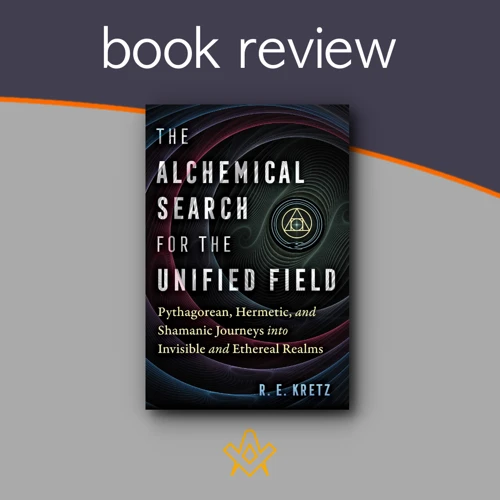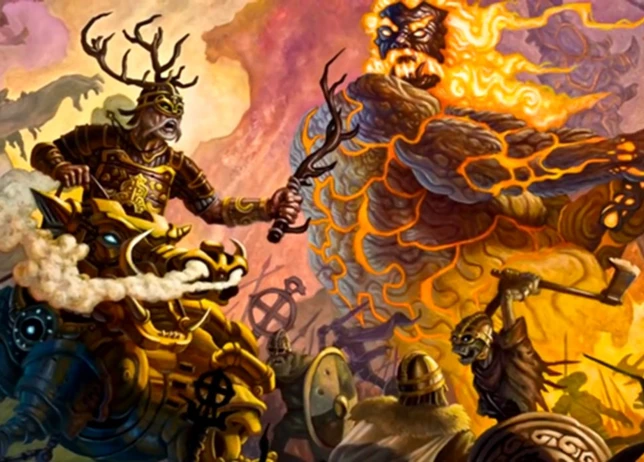The Role of Ragnarok in Norse Mythology: The Apocalypse of the Gods
In the rich tapestry of Norse mythology, few events hold greater significance than Ragnarok. This cataclysmic event, also known as the “Apocalypse of the Gods,” marks the end of the current world and ushers in a new era. Ragnarok is a tale of cosmic proportions, filled with epic battles, divine prophecies, and profound symbolism. From the clash of gods and giants to the devastation wrought by natural disasters, Ragnarok encapsulates the cyclical nature of existence and explores themes of moral reckoning and rebirth. Its influence can be seen throughout literature, art, and even in popular culture. Join us on a journey as we delve into the captivating role of Ragnarok in Norse mythology.
What is Ragnarok?

Ragnarok, derived from Old Norse words meaning “fate of the gods,” represents the apocalyptic event in Norse mythology that brings about the end of the world. It is a key element in the cycle of creation and destruction, signifying the cyclical nature of existence. Ragnarok is described in various Norse texts, including the Poetic Edda and the Prose Edda, which provide detailed accounts of the prophesied events leading up to the cataclysm.
According to the mythology, Ragnarok will be triggered by a series of events, including the release of the monstrous wolf Fenrir, the death of the god Baldr, and the breaking of the chains that bind the trickster god Loki. These events will throw the realms of gods, humans, and mythical creatures into chaos and set the stage for the ultimate battle between the forces of good and evil.
During Ragnarok, the gods will face off against the giants in an epic battle that will determine the fate of the cosmos. This climactic conflict, known as the “Battle of the Gods,” will be characterized by intense violence and widespread destruction. Heroes, such as Thor and Odin, will fight valiantly against their adversaries, but ultimately, both gods and giants will perish in the fiery chaos.
Alongside the battle, Ragnarok is also accompanied by natural disasters of monumental scale. Earthquakes and floods will ravage the land, while the sky will darken, and the stars will disappear. The terrifying sea serpent Jormungandr, who encircles Midgard, the realm of humans, will rise from the depths of the ocean, flooding the lands and heralding the end of the world.
The Prophesied Events

The prophesied events leading up to Ragnarok are filled with foreboding and signify the impending doom of the world. According to Norse mythology, there are several key events that serve as harbingers of this apocalyptic event. The first is the breaking of the unbreakable chains that bind Loki, the mischievous trickster god. This signifies the release of chaos and sets in motion a chain of events that will deeply affect the realms of gods, humans, and mythical creatures alike. Another significant event is the death of Baldr, a beloved god associated with light and purity. His demise is seen as a symbol of the approaching darkness and the loss of innocence. Additionally, the monstrous wolf Fenrir, who had been magically bound, will break free from his restraints, signaling the imminent threat of destruction. These prophesied events intertwine and foreshadow the cataclysmic climax of Ragnarok, where beings from every realm will converge in a final battle of cosmic proportions. For more information on the importance of runes in Norse mythology divination, you can visit this link.
The Battle of the Gods
The Battle of the Gods is the climactic event of Ragnarok, where the forces of good and evil clash in an epic struggle for dominance. As the prophesied end of the world draws near, the gods assemble their armies and prepare for the ultimate confrontation. Led by Odin, the Allfather, and his mighty son Thor, the gods charge into battle, wielding their enchanted weapons and displaying their divine powers.
The opposing force is comprised of the giants, powerful beings known for their immense strength and size. Led by the monstrous Surtr, a giant engulfed in flames, the army of giants marches towards the battlefield with the intent to annihilate the gods. The clash between these two formidable forces shakes the very foundations of the cosmos, unleashing a maelstrom of chaos and destruction.
Heroes from both sides engage in fierce combat, fighting with valor and determination. Thor, the god of thunder, wields his hammer Mjolnir, striking down giants with each thunderous blow. Odin, the wise and cunning ruler of the gods, employs his vast knowledge and magical abilities to confront his foes. Other gods like Tyr, Freyr, and Heimdallr also join the fray, using their unique skills and weapons to defend their realm and preserve their existence.
Despite their valorous efforts, the gods are ultimately doomed to fall in battle. The powerful Surtr, wielding his fiery sword, proves to be an unstoppable force. He engages in a fatal duel with the god Freyr and strikes him down, symbolizing the victory of chaos and destruction over the forces of order and creation. Slowly, the gods succumb to their wounds and are consumed by the flames of Surtr and his army.
The Battle of the Gods, though devastating, carries significant symbolism. It represents the eternal struggle between order and chaos, light and darkness. It signifies that even the divine powers are unable to escape the cyclical nature of creation and destruction. The outcome of this battle sets the stage for the rebirth of the world and the beginning of a new era.
The aftermath of the battle sees the cleansing fires of Surtr’s flames engulfing the realms, burning everything to ashes. From these ashes, a new world will rise, bringing about the renewal of existence and the start of a fresh cycle. This theme of rebirth and renewal is a central aspect of Norse mythology, emphasizing the cyclical patterns that govern the universe.
Click here to learn more about the realms in Norse mythology.
The Coming of the Giants
The coming of the giants is a pivotal part of the Ragnarok prophecy in Norse mythology. As the end of the world draws near, these formidable beings play a significant role in the apocalyptic events that unfold. Giants, known as Jotnar in Norse mythology, are powerful and often hostile creatures who inhabit the realm of Jotunheim. In the lead-up to Ragnarok, the giants will break free from their traditional boundaries and march towards Asgard, the realm of the gods.
Led by the mighty fire giant Surtr, the giants will descend upon the realm of gods with their immense strength and ferocity. Surtr, wielding a flaming sword, will exude intense heat and blaze a path of destruction as he advances towards the final battle. His arrival signals the beginning of the end, as his fiery presence engulfs the world in flames.
The giants’ assault on Asgard represents the clash between chaos and order, with the forces of chaos seeking to overthrow the established order of the gods. Their inclusion in the Ragnarok narrative adds a sense of danger and unpredictability, heightening the dramatic tension of the impending apocalypse.
While the gods, with their own formidable powers, will resist the onslaught of the giants, the outcome of this cosmic battle is predetermined. The gods will ultimately succumb to their foes, and the giants will emerge victorious. This turning of the tides underscores the cyclical nature of Norse mythology, where destruction paves the way for rebirth, and the cycle begins anew.
The coming of the giants in Ragnarok showcases the formidable nature of these mythical creatures and their pivotal role in the cataclysmic events of the Norse apocalypse. For more information on the realms of Norse mythology, you can explore our article on Norse Mythology Realms.
The Natural Disasters
During Ragnarok, the world will be thrown into a state of chaos and devastation, with natural disasters of unprecedented scale wreaking havoc across the realms. The cataclysmic events that unfold during this apocalyptic period signify the end of the current world as we know it.
One of the most prominent natural disasters associated with Ragnarok is the flooding of the lands. As the fearsome sea serpent, Jormungandr, rises from the depths of the ocean, it unleashes massive tidal waves that engulf the coasts and low-lying areas. The powerful force of these floods is instrumental in signaling the approaching end.
Simultaneously, the skies darken, and the stars disappear, plunging the world into eternal night. This celestial phenomenon adds to the sense of impending doom and signifies the disruption of the natural order. The absence of light symbolizes the chaotic forces at play during Ragnarok, as the very fabric of the universe unravels.
Earthquakes become a common occurrence, shaking the foundations of the realms. The quaking of the earth’s crust is a metaphorical representation of the upheaval and destruction that Ragnarok brings. Mountains crumble, forests burn, and the once-stable lands are reshaped by the violent forces of nature.
Amidst the chaos, there is a loss of balance and harmony as the realms are consumed by a primal frenzy. The destructive power of these natural disasters serves to cleanse and prepare the world for the inevitable rebirth that follows the end of Ragnarok.
The imagery of natural disasters during Ragnarok reflects the Norse understanding of the cyclical nature of existence. It highlights the transient and impermanent nature of the world, emphasizing the need for renewal and regeneration. Through the destruction brought about by these cataclysmic events, the stage is set for a new beginning, where life can emerge once again.
For more information on mythical creatures and their role in Norse mythology, refer to our article on Norse Mythology: Humans and Mythical Creatures.
Symbolism and Meaning

Symbolism and meaning lie at the heart of the Ragnarok myth, offering profound insights into the human experience and the cycle of life. Ragnarok represents both an end and a beginning, symbolizing the cyclical nature of existence. The destruction of the current world marks the end of one era, but it also paves the way for the birth of a new one. This duality reflects the universal theme of transformation and renewal. Ragnarok serves as a moral and ethical reckoning, where the actions and choices of the gods and humans come to bear consequences. It highlights the importance of personal responsibility and the consequences of one’s actions. The myth reminds us of the fragility and impermanence of the world while emphasizing the resilience and potential for growth that arises from destruction. It serves as a reminder to face adversity with courage and to find meaning and purpose even in the face of impending doom.
End and Beginning
Ragnarok represents not only the end of the world but also the beginning of a new era. It symbolizes the cyclical nature of existence, where destruction paves the way for rebirth and renewal. In Norse mythology, the world is destined to be destroyed and recreated multiple times, and Ragnarok is just one iteration of this eternal cycle.
The cataclysmic events of Ragnarok mark the end of the current world, a world tainted by greed, injustice, and moral corruption. The gods are held accountable for their actions, and their downfall signifies a moral and ethical reckoning. It is a period of chaos and destruction, where the old order collapses under the weight of its own shortcomings.
However, amidst the devastation, seeds of hope are sown. Ragnarok represents a necessary purge, clearing the path for a new world to emerge. It is a time for the gods and the universe itself to undergo a profound transformation. While the gods and giants may meet their fate, the legends tell of a few survivors who will bring forth a new generation and lay the foundation for a fresh start.
The concept of Ragnarok embodies the idea of death and renewal, highlighting the inevitability of change and the cyclical nature of existence. It teaches the lesson that even in the face of utter destruction, there is always the potential for rebirth and the opportunity to learn from past mistakes.
So, Ragnarok serves as a reminder that endings are not solely moments of despair but also opportunities for new beginnings. Through its symbolism, it encourages reflection, introspection, and the pursuit of a better, more virtuous future. Ragnarok teaches us that even in times of darkness, there is always a flicker of hope, ready to ignite a new era of light and possibility.
Moral and Ethical Reckoning
The concept of moral and ethical reckoning is deeply intertwined with the narrative of Ragnarok in Norse mythology. As the world comes to its fiery end, the gods face a final judgment where their actions and behavior throughout the ages are evaluated. This reckoning serves as a reflection of the moral choices made by both the deities and humanity in the face of impending doom.
One noteworthy aspect of this moral reckoning is the fate of some gods who have indulged in deceit, greed, or other negative traits. Loki, the trickster god, exemplifies this moral assessment as his actions throughout Norse mythology often disrupt the harmony among the gods and lead to dire consequences. During Ragnarok, Loki’s role as an instigator in the events leading up to the cataclysm is confronted, and he faces his own judgment and punishment for his treachery.
The moral and ethical reckoning presented in Ragnarok reflects the core values and ideals of ancient Norse society. The gods are held accountable for their actions, just as humans were expected to be responsible for their deeds during their lifetimes. This serves as a reminder that moral choices have consequences, and one’s actions are ultimately subject to judgment.
In this moral and ethical reckoning, Ragnarok also presents an opportunity for redemption and growth. It symbolizes a chance for the gods and humanity to learn from their mistakes and strive for a better future. It teaches the importance of reflecting on one’s actions and their impact on the world around them, emphasizing the power of personal responsibility and the significance of moral virtues.
The theme of moral and ethical reckoning in Ragnarok continues to resonate in modern times. It prompts individuals to reflect on their own moral choices and strive for personal growth, reminding us that our actions have consequences and that we have the power to shape our own destiny through our moral decisions.
Legacy and Influence
The legacy and influence of Ragnarok in Norse mythology extend far beyond the ancient tales themselves. Throughout history, this cataclysmic event has served as a powerful symbol with profound cultural significance. In literature, Ragnarok’s themes of destruction and rebirth have been explored in various forms, inspiring authors to examine the cycles of life and the moral consequences of human actions. Artistic depictions of Ragnarok, whether in paintings or sculptures, have captured the apocalyptic imagery and the dramatic clash between gods and giants. Ragnarok has found its place in modern popular culture, with references in literature, films, and even video games, showcasing its enduring appeal. The influence of Ragnarok continues to resonate, reminding us of the impermanence of existence and the eternal struggle between light and darkness.
Literature and Art
Literature and art have been profoundly influenced by the concept of Ragnarok in Norse mythology. The cataclysmic event has served as a rich source of inspiration for countless writers and artists throughout history.
In literature, Ragnarok has been depicted in various forms. The most notable portrayal can be found in the Poetic Edda and the Prose Edda, where detailed accounts of the events leading up to and during Ragnarok are provided. These texts have become crucial sources for understanding Norse mythology as a whole and have shaped subsequent interpretations of the apocalypse.
Additionally, authors have drawn upon the themes and symbolism of Ragnarok to explore existential and moral dilemmas in their works. The concept of a world-ending event forces characters and readers alike to confront questions of mortality, fate, and the cyclical nature of existence.
Artistic representations of Ragnarok can be found across different mediums, including paintings, sculptures, and illustrations. These works often capture the epic battles, cosmic destruction, and dramatic moments of the apocalypse. Artists have used their creative vision to depict the gods clashing with giants, the fiery destruction of the world, and the subsequent rebirth that follows. The works of artists such as Johannes Gehrts, Emil Doepler, and Arthur Rackham are notable examples of visual interpretations of Ragnarok.
The influence of Ragnarok extends beyond traditional forms of literature and art. It has permeated popular culture, appearing in various forms of media such as films, video games, and comic books. From Marvel’s portrayal of the ultimate battle between Thor and Loki in the Marvel Cinematic Universe to the epic battles in video games such as God of War, Ragnarok has captivated audiences and further solidified its place in modern storytelling.
The rich symbolism and dramatic nature of Ragnarok have made it a popular and enduring theme in literature and art. Its depiction in various forms continues to fascinate and inspire audiences, serving as a testament to the enduring power of Norse mythology.
Pop Culture References
Pop Culture References:
The concept of Ragnarok, with its epic battles and world-ending catastrophe, has captured the imagination of various forms of pop culture. From movies and TV shows to video games and literature, Ragnarok has made its mark, often portrayed as a dramatic and climactic event.
1. Marvel Cinematic Universe (MCU): Ragnarok gained significant recognition in popular culture through its depiction in the Marvel film “Thor: Ragnarok.” Released in 2017, the movie showcased Thor’s journey to prevent the destruction of Asgard during the prophesied Ragnarok. The film added a unique twist to the mythological narrative while incorporating elements from the comics. It introduced a charismatic villain, Hela, and emphasized the theme of rebirth and renewal.
2. Video Games: The notion of Ragnarok has also become prevalent in video games. “God of War,” a highly acclaimed game series, draws inspiration from Norse mythology and prominently features Ragnarok as a central plot point. Players embark on a mythic adventure, guiding the protagonist, Kratos, through the realms to prevent the cataclysmic event. The game’s immersive storytelling and stunning visuals have captivated audiences worldwide.
3. Literature: Ragnarok has been a recurring theme in literature, both in retellings of Norse mythology and in works inspired by it. Authors have depicted Ragnarok in various ways, exploring its symbolic and moral implications. Neil Gaiman’s book “Norse Mythology” and Joanne Harris’ novel “The Gospel of Loki” are examples of contemporary literature that delve into the rich lore of Norse mythology, including Ragnarok.
4. Music: Popular music has also drawn inspiration from Ragnarok. Numerous bands and artists have incorporated the concept into their lyrics and album artwork. The Norwegian black metal band Bathory released an album titled “Twilight of the Gods,” which explores the themes of Norse mythology and Ragnarok. Other artists, such as Amon Amarth and Tyr, have crafted songs that vividly depict the apocalyptic battle and its aftermath.
Ragnarok’s pervasive presence in pop culture demonstrates its enduring appeal and the power of its mythological storytelling. It continues to inspire and captivate audiences across various mediums, solidifying its place in the collective imagination of modern society.
Conclusion
In conclusion, Ragnarok stands as a pivotal event in Norse mythology, representing the ultimate cataclysm and the subsequent rebirth of the world. It embodies the cycle of destruction and creation, symbolizing the inherent transience and cyclical nature of life. Ragnarok encompasses not only the climactic battle between gods and giants but also the moral and ethical reckoning brought upon by the apocalyptic events.
The significance of Ragnarok extends beyond the realm of mythology, permeating various aspects of human creativity and culture. It has inspired countless works of literature and art, captivating audiences with its grandeur and cosmic themes. From the poetic verses of the Eddas to modern adaptations in popular culture, Ragnarok continues to fascinate and ignite the imagination of people worldwide.
The legacy of Ragnarok serves as a reminder of the impermanence of existence, the fragility of power, and the cyclical nature of life and death. It prompts contemplation on the consequences of our actions and the potential for redemption. As we explore the rich tapestry of Norse mythology and unravel the intricate threads of Ragnarok, we gain insight into the depths of human nature and the eternal forces that shape our world.
Through its vivid imagery, profound symbolism, and enduring impact, Ragnarok remains an iconic tale that transcends time and culture. It teaches us about the inevitable cycles of life, the ever-present struggle between good and evil, and the transformative power of renewal. So let us continue to delve into the realms of mythology and discover the profound wisdom that lies hidden within the stories of Ragnarok and the gods of Norse mythology.
Frequently Asked Questions
FAQs about Ragnarok
1. What is the significance of Ragnarok in Norse mythology?
Ragnarok represents the apocalyptic event in Norse mythology that brings about the end of the world and the beginning of a new cycle of creation.
2. Is Ragnarok considered a literal event or a symbolic representation?
Ragnarok is both a literal event and a symbolic representation. It portrays the cyclical nature of existence, highlighting themes of destruction, renewal, and moral reckoning.
3. Who are the main players in Ragnarok?
The main players in Ragnarok are the gods, giants, and various mythical creatures. Gods such as Thor, Odin, and Loki play significant roles in the events leading up to and during Ragnarok.
4. What triggers Ragnarok?
Ragnarok is triggered by a series of events, including the release of the monstrous wolf Fenrir, the breaking of Loki’s chains, and the death of the god Baldr.
5. What happens during the Battle of the Gods?
During the Battle of the Gods, the gods face off against the giants in an epic conflict that determines the fate of the cosmos. Heroes like Thor and Odin fight valiantly, but ultimately, both gods and giants perish.
6. What natural disasters are associated with Ragnarok?
Ragnarok is accompanied by natural disasters such as earthquakes, floods, and a darkening of the sky. The sea serpent Jormungandr also rises from the ocean, causing widespread devastation.
7. What does Ragnarok symbolize?
Ragnarok symbolizes the end and beginning of a new cycle. It represents the moral and ethical reckoning of the gods, the inevitability of destruction, and the potential for rebirth and renewal.
8. How has Ragnarok influenced literature and art?
Ragnarok has been a significant influence on various works of literature and art. It has been featured in Norse sagas, epic poems, and modern interpretations, showcasing its enduring appeal and symbolism.
9. Are there any pop culture references to Ragnarok?
Yes, Ragnarok has made its way into popular culture. It has been depicted in movies, books, comics, and video games, often serving as a source of inspiration for epic battles and world-ending scenarios.
10. How does Ragnarok relate to other aspects of Norse mythology?
Ragnarok is deeply intertwined with other aspects of Norse mythology, including the belief in a cyclical cosmos, the existence of different realms, and the heroism and fallibility of the gods themselves.








